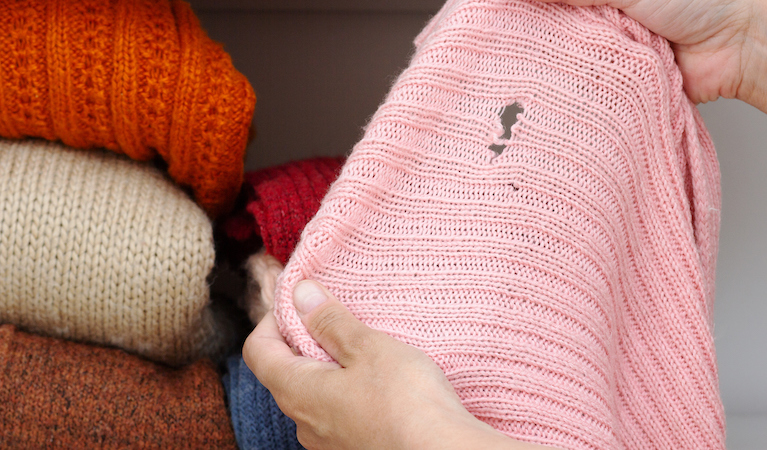We use cookies to improve your experience on our websites and to analyse how and when our sites are used. By clicking 'Accept all & continue' you're agreeing to our use of cookies. To learn more about the cookies we use, you can read our cookie policy.
Opt out of non-essential cookies
This article is the latest in Loans 2 Go’s series of Domestic Disaster articles, which provide helpful guidance as to what to do when things go wrong.
Previous articles include:
One problem that a lot of people face in spring is moths. Whilst moths can appear at any time of the year, they are likely to be at their most active in spring as they emerge from their winter cocoons once the weather starts to warm up.
So, in this article we take a brief look at:
There are over 2,500 different kinds of moths in the UK, but the three most common types you are likely to see in your home are the clothes moth, carpet moth and pantry moth.
Clothes moths are very small brown moths, only around 6mm in length. The proper name of the clothes moth is Tineola Bisselliella. But these moths have become known as clothes moths because they feed on the protein keratin which is found in natural animal fibres used in clothing materials such as wool, silk and leather
Clothes moths can happily exist in dark enclosed areas such as wardrobes, so you may not realise they are there until you see evidence of damage (see next section). But once you find them they need dealing with straight away as female clothes moths can lay up to 200 eggs a year so you could soon have an infestation on your hands.
Carpet moths are properly called Trichophaga Tapetzella. They are larger than clothes moths and usually darker; although their bodies are slightly translucent so their colour can vary depending what they are eating.
Their preferred food is soft furnishings; not just carpets but also curtains, bedding, and cushions. They like a dark, warm, humid environment, so are likely to hide in carpets and skirting boards around radiators or hot pipes.
Carpet moths also reproduce as quickly as clothes moths, so can turn into an infestation very quickly.
Less common than clothes or carpet moths, pantry moths are usually Indian meal moths, which are small reddish brown moths. Pantry moths can sometimes be found in dried foods such as pasta, cereal, rice and flour. If this is the case, then a moth infestation could soon spread to your kitchen cupboards.
As well as it being unpleasant having moths fluttering around your home, there are specific problems that they can cause. Some of the most common are:
This is probably the best-known sign of a moth. If you pull a garment out of the wardrobe and mysterious holes have appeared, it’s pretty certain that you have moths.
If your soft furnishings are beginning to look worn, check them more closely. Items such as carpets, curtains, bedding and cushions might look as if the fabric is wearing away, but it could be moths eating them.
If you open a wardrobe or cupboard door and one or more moths fly out, don’t just ignore it. Even if no damage has yet been done, you need to take action now to stop things getting worse.
Who knew?! Moth larvae can create spider-like webs in areas they frequent. Moth webs are most commonly seen outdoors, for example white or grey silk webbing on plants or trees. However, it is also possible to have moth webs in your home, particularly with pantry moths.
So, moths are definitely not good news. But if you do find them in your home, what should you do? Let’s take a look.
If you discover moths in your home, there are various things you can try to do yourself to see if that sort out the problem. These include:
Thorough vacuuming may be able to get rid of carpet moths if you catch things early enough. You need to be very sure to pay extra attention to warm humid areas where moths are likely to hide. And also bear in mind that you need to get up any moth eggs : if you leave any behind there could soon be another infestation. And make sure you give the hoover a good clean out afterwards in case there are any eggs still in there.
You need to clean your home and soft furnishings really thoroughly to get rid of any moth eggs that may still be there. Try using a lavender-scented cleaning solution as this can help to repel bugs. Another alternative is a mixture of vinegar and very hot water. A carpet steamer can also help, as the heat should kill off any remaining moth life.
If you have had moths in your wardrobe, the best thing to do is to wash everything at the highest temperature possible for the fabrics. It’s a good idea to put clothes in bags while taking them to the washing machine to avoid the risk of any moth eggs spreading from the clothing into other parts of your home.
If you have had pantry moths, the best thing is to get rid of any dried food before completely cleaning out the cupboard(s) they have been in. When you replace the dried food you may want to rinse it thoroughly in boiling water, redry it then store in a sealed tin or box.
There are many different insecticides available, some of which are specific to moths. So, another option is to use this wherever there are any signs of moths and see if it will achieve the desired results.
If you try the above measures and still have a problem, it’s probably time to call a pest control professional. You can google local pest control companies but also check with others – friends, family and local social media – for word of mouth recommendations. If you need some extra funds to get this sorted, remember that an emergency loan from Loans 2 Go may be able to help you sort things out.
We hope that this article has given you some useful information on the damage moths can cause, and what to do about them.
Do visit us here again soon for more lifestyle and financial tips from Loans 2 Go.











© 2024 Loans 2 Go. All rights reserved.